Variable Rate Corn Planting: Enhancing Crop Yields
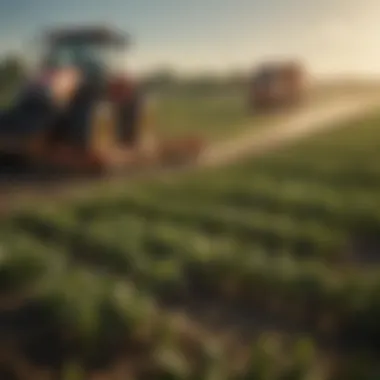

Overview of the Topic
Definition and Importance
Variable rate corn planting is an innovative approach within precision agriculture, allowing farmers to apply seeds and nutrients at varying rates across different parts of a field. The main goal is to optimize yields while minimizing waste and input costs. Precision agriculture emphasizes data-driven decisions, and variable rate technology (VRT) is at the forefront of this shift. Farmers using this method can increase efficiency and sustainability in their farming practices. This technique is particularly relevant today, as agricultural production faces pressures from climate change and a growing global population.
Current Trends
In recent years, there has been a significant rise in the adoption of VRT due to advancements in technology. Integration of GPS, drones, and satellite imagery enables detailed assessments of field variability. Modern software allows for real-time data analysis, which helps in making timely decisions aligned with specific field conditions. Notably, the trend is shifting towards using comprehensive data sets that consider soil health, moisture levels, and crop needs.
Key Techniques and Practices
Step-by-Step Guide
- Data Collection: Gather data from soil tests and previous crop yields. This will help understand the variability in the field.
- Field Mapping: Create a map that highlights different zones within the field. This is critical for applying variable rates appropriately.
- Prescription Creation: Develop a prescription map indicating specific planting rates per zone.
- Implementation: Use specialized equipment or software to plant according to the prescription map.
- Monitor and Adjust: After planting, continue monitoring crop performance. Adjust practices as needed for future seasons.
Tools and Equipment Needed
- GPS Technology: Essential for accurate mapping and data collection.
- Variable Rate Planters: These machines allow for different planting rates across a field.
- Soil Sensors: They provide real-time data on soil conditions, enabling informed decisions.
- Analytical Software: Programs that can analyze collected data and help in creating prescriptions.
Challenges and Solutions
Common Obstacles
- High Initial Costs: Investing in the technology can be expensive for many farmers.
- Data Overload: With large amounts of data, farmers may struggle to identify useful insights.
- Technical Skill Requirements: There is often a learning curve with new technologies.
Innovative Solutions
- Cost-Sharing Programs: Many agricultural cooperatives offer support to alleviate high costs.
- Training Workshops: Organizations are providing training on data analysis and technology use.
- Incremental Implementation: Farmers can start small, focusing on high-impact areas before scaling up.
"Precision agriculture, particularly variable rate corn planting, represents a near future where efficiency is maximized while environmental impacts are minimized."
This comprehensive approach not only enhances crop yields but also promotes sustainable farming practices, making it increasingly important for modern agriculture.
Intro to Variable Rate Corn Planting
In agriculture, corn is one of the most significant crops due to its wide applications, from food products to biofuels. As farming practices progress, variable rate corn planting has emerged as a prominent technique, reshaping how farmers approach crop management. The core objective is to optimize planting and resource input for each specific field area based on varying conditions. This targeted methodology not only increases yields but addresses the growing need for efficiency in resource usage, thereby promoting sustainability.
Understanding this approach requires familiarity with several facets. It involves not just technology, but critical thinking and analysis of field conditions. Farmers and enthusiasts need to grasp how variable rate technology can impact their specific agricultural practices. Let's dig deeper into two essential components: the concept of variable rate technology and its importance in modern agriculture.
The Concept of Variable Rate Technology
Variable rate technology (VRT) is the practice of applying different rates of inputs across a given field. Inputs can include seeds, fertilizers, and pesticides, and they are adjusted according to data that reflects the field's condition. This process relies heavily on agricultural sensors, GPS mapping, and data analysis tools.
For example, soil sensors might indicate that a specific area of a field has lower nutrients. In response, a farmer can increase fertilizer application in that region while reducing it where the soil has sufficient nutrients. This tailored application not only improves the growth potential of the corn crop but also minimizes waste and reduces environmental impact.
Importance in Modern Agriculture
The significance of variable rate corn planting becomes clearer when considering its multiple advantages. Primarily, it contributes to enhanced productivity. By pinpointing and responding to varying field conditions, farmers can maximize yield potential. This benefit is crucial as global food demand continues to rise.
Another critical aspect is resource efficiency. Traditional blanket applications of fertilizers or seeds can lead to overuse, resulting in wasted resources and increased costs for farmers. Variable rate planting allows for precise input management, which ultimately leads to reduced costs and increased profitability.
Moreover, environmental considerations hold increasing importance in the dialogue around agriculture today. Excessive fertilizer runoff can cause detrimental effects on local ecosystems and water sources. With VRT, the risk of over-application is minimized, helping to protect natural resources while still meeting crop needs.
"Variable rate technology is a fundamental shift in how inputs are managed, aligning agricultural practice with modern sustainability goals."
The adoption of variable rate corn planting is not merely a technological upgrade; it signifies a shift towards more sustainable and economically viable farming practices. As agricultural challenges continue to evolve, understanding this approach becomes essential for farmers aiming to stay competitive and responsible in their practices.
Fundamentals of Corn Planting Practices
Understanding the fundamentals of corn planting is essential for utilizing modern techniques like variable rate planting. This foundation encompasses traditional methods and addresses challenges that arise with conventional practices. A clear grasp of these basics allows farmers to appreciate the benefits of innovative strategies that can significantly optimize yields.
Traditional Corn Planting Techniques
Traditional techniques for planting corn have been dominant for many years. Farmers typically used a uniform planting density across whole fields. This approach relied on broad assumptions about soil fertility and moisture.
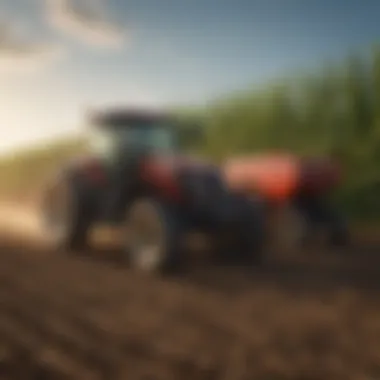
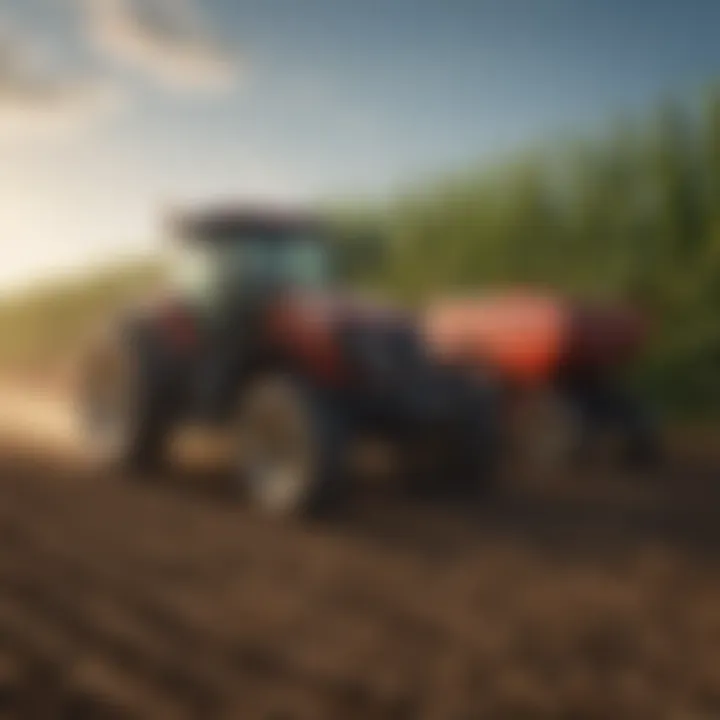
Key aspects of traditional techniques include:
- Fixed Population: Planting at a set number of seeds per acre, disregarding variability in soil type or other factors.
- One-size-fits-all Approach: The same practices applied to the entire field, often leading to over- or under-planting in certain areas.
- Manual Labor: In many instances, planting was done manually or with basic machinery, which often resulted in inefficiencies.
While effective in some settings, these techniques often ignore the diverse characteristics of individual fields. Uniformity can lead to suboptimal growth in less than ideal conditions. By understanding these traditional methods, farmers can see the importance of adapting their strategies to suit specific field conditions.
Challenges with Standard Practices
Standard practices in corn planting come with their own set of limitations. Failing to account for field variability can result in several challenges:
- Resource Mismanagement: Using the same inputs across different areas can either waste resources or contribute to poor crop performance.
- Yield Variability: Different parts of a field produce varying yields based on soil quality, moisture levels, and other environmental factors. Not recognizing these factors leads to inconsistent output.
- Economic Impact: Farmers may invest time and money into practices that do not optimize their returns. This could be due to wasted seeds, fertilizer, or water, leading to losses.
"Understanding field variability is key to improving both yields and resource efficiency in corn production."
There is a need for farmers to transition from traditional methods to approaches that consider the specific demands of their land. This requires knowledge, investment in technology, and an openness to change. Recognizing the limitations of standard practices is the first step toward adopting more effective strategies like variable rate corn planting.
Benefits of Variable Rate Corn Planting
Variable rate corn planting is an important component of precision agriculture. It allows farmers to tailor their planting strategies to specific field conditions. This approach has several benefits that are essential for both productivity and sustainability in modern farming.
Enhanced Yield Potential
Enhanced yield potential is one of the most significant advantages of variable rate corn planting. By analyzing soil types and moisture levels across a field, farmers can determine the optimal planting density. This ensures that each corn plant has the right amount of resources to thrive, which can lead to better yields. For instance, denser planting might be beneficial in fertile areas, while sparse planting could be more appropriate in less productive sections.
Moreover, using variable rate technology can help identify areas that perform below potential. As a result, targeted interventions can be applied only where necessary, preventing wastage of resources. Farmers using these techniques often see a measurable increase in crop output, which contributes directly to profitability. In essence, this approach makes it possible to maximize the available yield potential by using data-driven insights.
Efficiency in Resource Use
Efficiency in resource use is another crucial benefit of adopting variable rate corn planting. This method allows farmers to apply water, fertilizers, and pesticides exactly where they are needed. Instead of using a one-size-fits-all approach, this precision technology minimizes input waste and reduces overall costs.
For instance, with soil sensors and GPS mapping, farmers can apply nitrogen fertilizer only to areas that require it. This localized approach not only saves money but also ensures that inputs are used judiciously, preserving both resources and the environment. By optimizing the application rates, farmers are able to achieve higher returns on investments while maintaining healthy soil conditions.
- Reduction in input costs
- Improved plant health
- Less environmental impact from runoff
Environmental Impact Considerations
Environmental impact considerations are gaining more focus as agriculture adapts to newer technologies. Variable rate corn planting encourages more sustainable farming practices. By optimizing input applications, farmers have the potential to reduce their environmental footprint significantly.
The precise application of nutrients helps limit runoff into nearby waterways, reducing problems like algae blooms and water pollution. Furthermore, the targeted use of pesticides decreases the likelihood of harmful effects on non-target species, promoting biodiversity.
Farmers engaging in these practices may also benefit from public support and enhance their reputation as environmentally conscious producers. The integration of variable rate technology thus contributes not only to financial gains but also to ecological preservation, making it a wise choice for the future of agriculture.
"Precision agriculture represents the convergence of technology and agriculture, enhancing both efficiency and sustainability."
In sum, the benefits derived from variable rate corn planting are numerous and significant. Farmers gain enhanced yields, greater efficiency, and a more positive environmental impact. Each element of this practice contributes uniquely to a smarter and more sustainable agricultural system.
Technological Components of Variable Rate Planting
The integration of technology in agriculture reshapes how farmers approach crop management. Technological components of variable rate planting allow for precise application of inputs tailored to specific field conditions. This leads to optimized yields and reduces waste. The significance of these technologies extends beyond just productivity; they promote sustainability and resource efficiency in farming practices.
GPS and Mapping Technologies
GPS technology is at the core of variable rate planting. It enables farmers to collect data regarding field topography and variations. Through accurate mapping, farmers can identify specific zones within a field that require different treatment levels. The implications are profound. Farmers can reduce over-application of seeds or fertilizers in areas that naturally yield more. This not only saves costs but also mitigates environmental impact.
The use of mapping technologies allows for the visual representation of variability across a field. Precision maps highlight areas with varying soil types, moisture content, and nutrient levels. The data collected can be layered with historical yield data, giving farmers actionable insights. These maps ensure that decision-making is based on comprehensive evidence rather than intuition alone.
Soil Sensors and Data Collection
Soil sensors contribute significantly to understanding field health and performance. These sensors continuously monitor soil moisture, temperature, and nutrient content. They provide real-time data that directs input applications more accurately. As a result, farmers can make informed decisions about when and how much to irrigate or fertilize.
Implementing soil sensors can lead to improved efficiency. Instead of following a schedule, farmers respond directly to soil conditions. This responsiveness is crucial during critical growth periods for corn, where timing can greatly influence yield potential. Moreover, the variability in soil can be monitored over time, creating a dynamic understanding of how to manage resources.
Variable Rate Equipment Technology
The technology behind variable rate application equipment is advancing rapidly. Modern seeders and fertilizer spreaders can adjust their operation based on the real-time data received from GPS and soil sensors. This means that different rates of seeds or nutrients can be applied to different sections of a field in one go.
Using variable rate equipment allows farmers to maximize input efficiency. For example, when planting corn, a farmer may choose to place seeds closer together in high-yield areas and further apart in less productive areas. This tailored approach leads to healthier plants and higher overall productivity. Additionally, this technology reduces wastage, providing significant economic benefits in the long run.


"Precision agriculture is not just about high-tech tools; it's about using data to make every decision count."
As technology develops, the importance of integrating these components into traditional practices becomes increasingly evident. By leveraging advanced GPS, soil sensors, and variable rate equipment, farmers can harness the full potential of their fields and adapt to the changing demands of agriculture.
Data Management and Analysis in Variable Rate Planting
In the domain of precision agriculture, data management and analysis serve as the cornerstone for optimizing variable rate corn planting. This process hinges heavily on accurate data collection and interpretation, which enables farmers to make informed decisions tailored to their specific agricultural landscapes. The rise of technology has transformed the way data is handled, moving from simple record-keeping to advanced analytical techniques. This evolution has been crucial for achieving enhanced crop yields while maximizing resource efficiency.
Interpreting Soil and Yield Data
Understanding soil and yield data is vital for effective variable rate corn planting. Soil data provides insights into nutrient availability, moisture levels, and other critical parameters that influence crop growth. Factors such as soil texture and structure must be analyzed to determine the appropriate seed rates, fertilizers, and other inputs specific to various field zones.
To interpret this data effectively, farmers often rely on tools like Geographic Information Systems (GIS) and precision ag software. These platforms can synthesize large volumes of data, allowing for more nuanced insights. By correlating soil properties with historical yield data, farmers can identify patterns that guide their planting strategies.
"Effective interpretation of soil and yield data directly impacts the decision-making process in variable rate planting, ensuring optimal resource allocation and enhanced productivity."
Key Performance Indicators in Agriculture
Establishing Key Performance Indicators (KPIs) is critical to evaluate the success of variable rate corn planting endeavors. KPIs provide measurable values that indicate how effectively the farming operation is meeting its objectives. In this context, a few notable KPIs include:
- Yield per Acre: This measures the productivity of each acre of land, helping to assess the effectiveness of planting strategies.
- Input Efficiency: Calculating the ratio of inputs used (like seed, fertilizer, and water) to the outputs achieved (crop yield) reveals operational efficiency.
- Soil Health Index: Monitoring changes in soil health can indicate the long-term sustainability of farming practices.
By actively monitoring these KPIs, farmers can adjust their practices to pursue continual improvement. Annual reviews of data, combined with seasonal adjustments, create a feedback loop that enhances future planting decisions and contributes to overall agricultural sustainability.
In summary, effective data management and analysis are crucial components of successful variable rate corn planting. Farmers must not only gather data but also interpret it to foster informed decision making. The emphasis on interpreting soil and yield data, combined with the use of KPIs, ultimately allows for more precise farming practices, which can lead to better yields and optimized resource use.
Implementing a Variable Rate Corn Planting Strategy
Implementing a variable rate corn planting strategy is vital in the context of modern agriculture. It harnesses the power of data-driven decisions and precision technology. The goal is simple: to optimize yield potential while utilizing resources efficiently and sustainably. Key elements in establishing this strategy involve understanding field variability, integrating modern technologies, and executing a practical plan.
Assessing Field Variability
Field variability refers to the differing conditions present within a single agricultural field. This includes soil type, nutrient content, moisture levels, and overall field topography. Evaluating these factors is essential before any planting strategy can be implemented. Farmer must analyze the data collected from soil samples, yield maps, and other relevant metrics. This analysis will inform how the crops will be planted and where to allocate different resources.
In practice, assessing field variability often includes:
- Soil Testing: Taking samples from various locations within the field to understand nutrient levels and pH balance.
- Yield Mapping: Using previous yield data to identify high and low performing areas within the field.
- Field Scouting: Regular visits to different field sections to observe conditions and gather qualitative data.
This comprehensive assessment forms the baseline for all subsequent decisions in a variable rate corn planting strategy.
Planning and Execution Steps
Once the variability has been assessed, effective planning and execution steps are required. This process involves several critical tasks:
- Data Integration: Combine soil and yield data to create a comprehensive overview of the field's requirements. This often involves software that can analyze complex datasets effectively.
- Variable Rate Maps: Develop variable rate application maps. These maps indicate where different seeding rates and nutrient applications are necessary based on the data gathered.
- Calibration of Equipment: Ensure that planting and application equipment is calibrated to respond to the variable rate maps. This guarantees the correct amount of seeds, fertilizers, or chemicals is applied.
- Execution: Carry out the planting based on the maps generated. It requires close monitoring to address any issues that may arise, such as equipment malfunction or unexpected weather changes.
- Post-Implementation Review: Following the planting season, farmers should conduct a review of the yield results against expectations. This analysis informs future planting seasons and helps refine the strategy further.
Successful implementation of a variable rate corn planting strategy not only improves yields but also contributes to sustainability in agriculture. As farmers adapt to ever-changing conditions, precision agriculture becomes indispensable for future productivity.
Case Studies and Practical Implementation
Examining case studies of variable rate corn planting offers valuable insights into practical implementation. These cases highlight real-world applications of technology and strategies adopted by farmers, providing a framework to understand best practices and potential pitfalls. With precision agriculture becoming increasingly relevant, such investigations allow us to grasp the tangible benefits that can emerge from targeted planting methods.
Some notable applications demonstrate the adaptability of variable rate planting across different geographical settings. Factors like soil type, climate, and economic viability influence how farms operate. Thus, assessing various implementations helps cultivate a comprehensive understanding that can be replicated or adapted elsewhere.
Research showcases that precision agriculture not only maximizes yields but also minimizes waste. Farmers can save on seeds and fertilizers, resulting in improved profitability.
Successful Applications in Different Regions
Different regions have embraced variable rate corn planting, each customizing the approach to fit local conditions. For instance, in the Midwest United States, farmers utilize high-resolution soil maps to adjust planting rates. In areas with a history of variable yields, farmers have noted significant improvements in average yields after adopting these methods. Some have reported yield increases upwards of 20% when strategic practices were employed alongside variable rate technologies.
In contrasting climatic conditions, like those in Brazil, variable rate planting has been used to manage diverse terrains. The implementation of soil sensors allowed farmers to monitor moisture levels and nutrient availability. This led to optimized planting density, which directly correlated with improved crop health and resilience.
- Midwest USA: High-resolution soil maps, yield improvements up to 20%.
- Brazil: Soil sensors used to manage moisture, optimized planting density, healthier crops.
Lessons Learned from Early Adopters
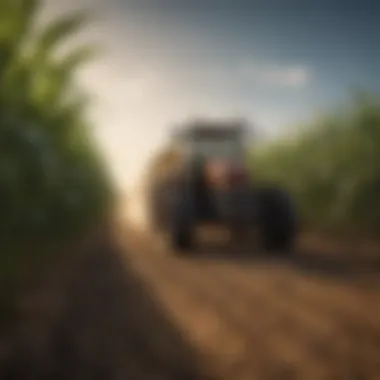
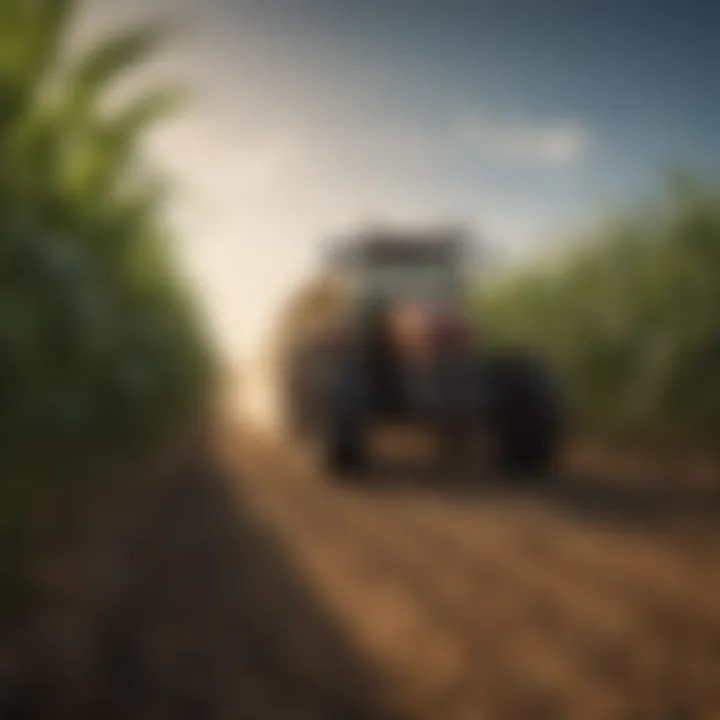
The journeys of early adopters provide critical lessons for others considering similar paths. One main takeaway is the importance of data management. Farmers quickly learned that having access to accurate and timely data is crucial for making informed decisions. This need drove many to invest in training and tools that aid in data interpretation.
Additionally, many experienced farmers shared challenges they faced when starting. For example, some highlighted the initial investment as a barrier. However, those who embraced technology earlier have reported gradual returns on investment through higher yields and reduced costs in the long run. The takeaway is clear: Early and careful planning can mitigate the upfront hurdles and lead to greater success.
- Data Management: Vital for informed decisions.
- Financial Considerations: Initial barriers can lead to long-term benefits.
Overall, case studies and practical implementations of variable rate corn planting are invaluable in understanding the nuance of precision agriculture. They provide concrete examples of benefits and challenges, offering essential frameworks for those interested in optimizing yields through innovative approaches.
Challenges of Variable Rate Corn Planting
Variable rate corn planting presents certain inherent challenges that can impede its full implementation and effectiveness. Understanding these challenges is crucial for farmers and agricultural enthusiasts looking to optimize their operations. By confronting these issues head-on, one can better appreciate how this precision agriculture technique can be integrated into various farming practices. Main obstacles can be divided mainly into two categories: technical and financial barriers, as well as knowledge gaps among farmers.
Technical and Financial Barriers
One of the significant obstacles to adopting variable rate corn planting lies in the technical and financial barriers that many farmers face. Implementing this technology often requires sophisticated equipment, such as GPS-guided machinery and advanced data management tools. These systems can be expensive and may necessitate significant upfront investments. As a result, small-scale farmers might find it challenging to justify these costs.
Moreover, there are maintenance costs associated with high-tech equipment that can deter adoption. Regular updates and repairs may add to the financial burden, reducing the net benefits that farmers expect from increased yields. Also, many rural areas have limited access to cutting-edge technology and services, which restricts effective utilization of these advancements.
"Investing in innovative tools is not just about buying equipment; it's about considering long-term gains versus initial costs."
Another challenge is the data management aspect. Farmers need a solid understanding of data analytics to interpret the information collected by sophisticated tools. If there is a lack of technical support or resources for data analysis, the effectiveness of the installation diminishes. Farmers may end up making decisions based on incomplete or poorly interpreted data, leading to less than optimal results.
Knowledge Gaps Among Farmers
In addition to the technical and financial constraints, there are considerable knowledge gaps among farmers regarding variable rate corn planting. The effective use of this technology demands a comprehensive understanding of agronomy, soil science, and data analysis. Unfortunately, many farmers do not possess the required expertise to navigate these complex fields.
Training opportunities in precision agriculture are often limited. Farmers may lack access to educational programs that cover the practical applications of variable rate planting, data interpretation, and equipment maintenance. Consequently, some may hesitate to transition from traditional practices to more advanced methodologies.
Furthermore, the agricultural community can be resistant to change. Many farmers stick to familiar practices due to uncertainty regarding the advantages of new technologies. This inclination can stymie innovation, resulting in slower adoption rates of variable rate corn planting techniques.
In summary, while variable rate corn planting can revolutionize agricultural practices, it is essential to address both technical and financial barriers and knowledge gaps. Tackling these challenges will lead to a more informed farming community and smoother transitions to precision agriculture.
Future Trends in Variable Rate Corn Planting
The evolution of variable rate corn planting is heavily influenced by ongoing advancements in precision agriculture and technological integration. As agricultural practices shift towards more data-driven methodologies, understanding these future trends becomes crucial for farmers aiming to optimize yields and resource efficiencies. This section addresses essential elements and considerations that will shape the landscape of variable rate corn planting in the years to come.
Advancements in Precision Agriculture
Precision agriculture continues to enhance the ways farmers manage their practices. Key advancements include improved sensor technologies, drones for aerial imaging, and enhanced data analytics tools. These tools enable farmers to gather detailed information about field conditions and crop needs at a granular level.
- Soil Health Monitoring: Advanced soil sensors can provide real-time data on moisture levels, nutrient composition, and pH. This data allows for precise adjustment of planting rates and fertilization schedules, directly influencing yield potential.
- Remote Sensing: Drones now offer sophisticated imaging technologies that assist in crop monitoring over large areas. These images help identify plant health and stress factors, allowing for targeted interventions.
- Data Management Software: Several platforms are becoming prevalent, providing farmers with the ability to manage and analyze vast amounts of data seamlessly. This software can integrate input from various sources, enabling better decision-making based on historical trends and current data.
These advancements not only streamline operations but also align with sustainable farming practices, reducing waste and enhancing profitability.
Integrating AI and Machine Learning
The integration of artificial intelligence and machine learning into agriculture marks a pivotal turn in how farmers approach crop planning and management. These technologies allow for predictive analytics, creating models that can foresee outcomes based on myriad variables.
- Predictive Farming Models: AI can analyze historical yield data and environmental conditions to predict future harvest outcomes. By adjusting planting strategies based on these predictions, farmers can mitigate risks and enhance yield security.
- Automated Decision Systems: Machine learning algorithms can help in making real-time decisions on when and how much to plant and water. Such systems reduce the manual labor involved and allow for quick adjustments to changing conditions.
- Precision Irrigation Control: By using AI-assisted models, farmers can optimize water usage, ensuring crops receive adequate hydration without waste. Custom irrigation strategies can be developed and adjusted based on ongoing analysis of soil and crop data.
"The merging of AI with farming processes heralds a new era where intuition is supported by data-driven insights, ultimately transforming expectations around production efficiency."
The future of variable rate corn planting is poised for growth as these technologies continue to advance. They not only present opportunities for yield optimization but also contribute to smarter, more sustainable farming practices.
Finale
Variable rate corn planting represents a significant advancement in precision agriculture. The importance of this technique cannot be overstated. It not only optimizes yields but also enhances the efficiency of resource utilization. As farmers face increasing pressure to produce more with less, variable rate technology offers a clear pathway forward.
Summarizing Key Insights
The key insights on variable rate corn planting include its ability to tailor inputs based on specific field conditions. This precision leads to improved crop performance and sustainability. Key benefits include:
- Enhanced Yield Potential: Use of data-driven approaches leads to better crop health and increased productivity.
- Efficient Resource Management: Reduction in seed and fertilizer waste ensures a smaller environmental footprint.
- Data Integration: Combining soil data with weather forecasts provides actionable insights.
Farmers leveraging these insights can make confident decisions that drive profitability while maintaining environmental integrity.
The Path Forward for Farmers
Farmers need to embrace the future trends in agriculture. By integrating sophisticated technologies, such as AI and machine learning, they can vastly improve their operations. Important steps include:
- Education and Training: Bridging knowledge gaps through workshops and online resources.
- Investing in Technology: Upgrading equipment to handle variable data inputs.
- Collaborating with Experts: Working alongside agronomists and data analysts to maximize data utilization.
Ultimately, farmers must recognize the potential of variable rate corn planting. Proactive adaptation to these changing agricultural landscapes will secure their success in the increasingly competitive market.



